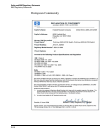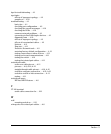
Index – 3
installation
connecting the switch to a power source … 2-15
horizontal surface mounting … 2-14
location considerations … 2-5
network cable requirements … 2-5
precautions … 2-3
rack or cabinet mounting … 2-8
site preparation … 2-5
wall mounting … 2-13
IP address
configuring … 3-2
IP telephones … 2-23
L
LEDs
behavior during self test … 2-8
checking during troubleshooting … 4-10
descriptions of … 1-4
error indications … 4-4
Fan Status … 1-4
Fault … 1-4
behavior during self test … 2-8
showing error conditions … 4-4
flashing definition … 1-5–1-6
location on switch … 1-3
on switch … 1-4
port
description … 1-6
Power … 1-4
behavior during self test … 2-8
Self Test … 1-5
behavior during self test … 2-8
link test … 4-11
location for the switch, considerations … 2-5
M
MDI-X to MDI network cable … A-10, A-12
MDI-X to MDI-X network cable … A-11
mini-GBICs
slot, location on switch … 1-3
mounting the switch
in a rack or cabinet … 2-8
precautions … 2-3
on a horizontal surface … 2-14
on a wall … 2-13
precautions … 2-13
Multiple-Display Port LEDs … 1-7
N
network cables
HP Auto-MDIX feature … A-8
required types … 2-5
twisted-pair connector pin-outs … A-8
twisted-pair, wiring rules … A-8
network devices
connecting to the switch … 2-17
network ports
connecting to … 2-17
location on switch … 1-3
types of … 1-3
non-standard network cables, effects … 4-2
O
out-of-band console access … 3-5
P
parts, included with the switch … 2-1
password
configuring … 3-2
passwords
deleting with the Clear button … 3-4
if you lose the password … 3-4
passwords, deleting … 1-8
physical specifications, switch … A-1
Ping test … 4-11
pin-outs
twisted-pair cables … A-8
PoE LED patterns … 4-8
PoE troubleshooting … 4-8
port configuration
checking when troubleshooting … 4-3
port LEDs
description … 1-6
normal operation … 2-8
ports
10/100Base-TX, location on switch … 1-3
connecting to … 2-17
console … 2-20
HP Auto-MDIX feature … A-8
network connections … 2-17
power connector … 1-9


















